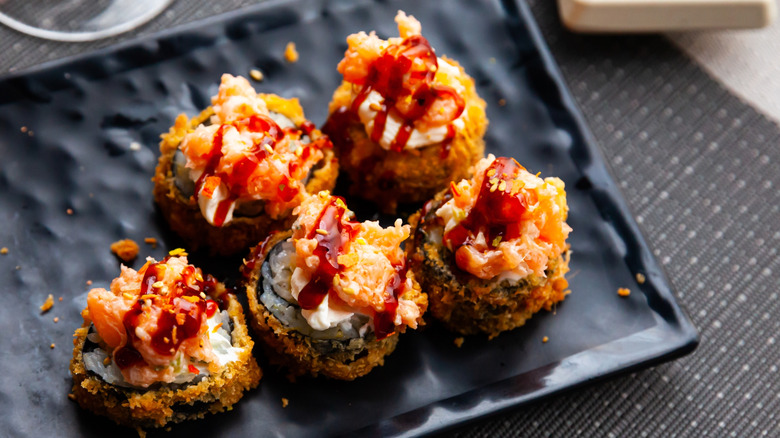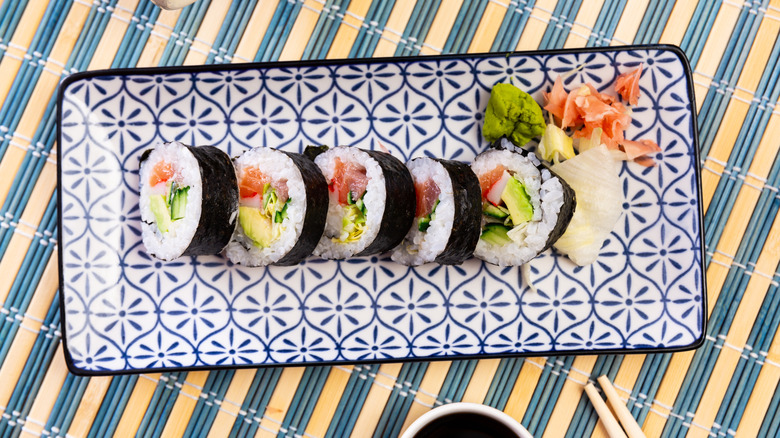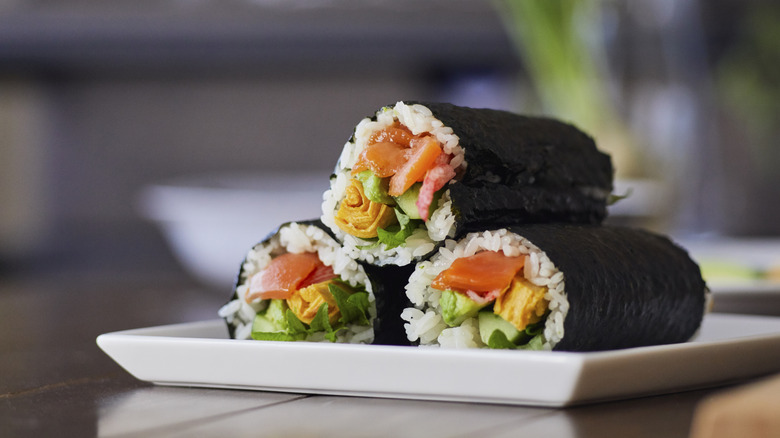Futomaki Is A Traditional Sushi Roll With Deep Roots And Big Flavors
From inarizushi (which is encased in fried tofu and eaten with the fingers) to the famous temaki (or hand roll), there truly is a sushi roll for every occasion. One such roll you might see if you spend any time in the west of Japan (or, nowadays, on many sushi restaurant menus) is the futomaki, a particularly traditional sushi roll with deep cultural roots, and equally deep flavors. Futomaki translates to "fat roll" in Japanese, likely a reference to its thickness in comparison to other sushi rolls. It's technically not a category of sushi in and of itself, rather, it's a type of makizushi (more commonly known as maki, the most well known type of sushi) that's rolled in seaweed and filled with a variety of colorful (and delicious) ingredients.
Similar to Korean kimbap, both in their visually striking cross section and varied, numerous fillings, they're sliced into rounds and usually eaten dipped in soy sauce. Sushi rice seasoned with sugar, salt, and vinegar forms the base, along with nori, seaweed dried especially for sushi making. The rolls are then typically filled with vegetables like cucumber, shiitake mushrooms, pickled daikon radish, and kanpyō, strips of gourd that are seasoned and dried. There isn't a standardized recipe for futomaki, so if you're making it yourself, feel free to customize! Some versions include tamago, a sweet Japanese omelette, while others incorporate imitation crab, or even unagi (grilled eel in a sweet, salty sauce), though bear in mind that most futomaki is traditionally vegetarian!
The history of futomaki
Sushi is an ancient art, dating back as far as the third century B.C., when it was used as a method of preserving fish in vinegar rice. It came into its modern form a little later in Japan's Edo period, which lasted from 1603 to 1868, when it moved from a method of preservation to a dish in and of itself, consisting of seasoned rice served with fish, egg, and vegetables (among other things). During this period the sushi roll became more popular thanks to the introduction of mass produced nori sheets (as a result of advancements in, of all things, paper making).
It was around this time when futomaki began to crop up in the west of Japan, particularly in the Kansai region, which is dominated by the cities of Osaka and Kyoto. Though perhaps less well known for its sushi making tradition than the capital city of Tokyo (located in the Edo prefecture, where the sushi tends to have a more clean cut, minimalist style), the sushi in Kansai is just as delicious, with a character all its own: The flavors are richer, sweeter, and the sushi itself is more colorful, and altogether more fun! It also has less of a distinct emphasis on fish, using ingredients such as tamago, or the aforementioned kanpyō. Futomaki likely emerged from this culture of playful, vegetarian sushi-making as a communal meal, emblematic of the philosophy of Kansai cuisine.
How is futomaki eaten today?
Futomaki continued to be popular as a communal, celebratory dish throughout the 18th and 19th centuries, and well into the modern era, where it became increasingly more popular outside of Kansai. It's most famously eaten (at least in its celebratory capacity) during Setsubun, an early February Japanese festival that marks the transition from winter to spring in the lunar calendar. On Setsubun, it's common to eat an entire roll of futomaki that hasn't been cut into pieces, known as ehōmaki. This holiday futomaki traditionally contains seven fillings. Each filling represents one of the seven gods of fortune in Japanese legend, which in turn each represent a different type of good luck. It's kept whole, traditionally, in order to preserve the eater's good fortune for the future, and is eaten facing a specific "auspicious direction" in silence, while making a wish — hence the meaning of ehōmaki, which translates into English as "lucky direction roll"!
Nowadays, it's common throughout the year, not just at Setsubun, but also at family gatherings, celebrations, and hanami, the annual viewing of the cherry blossoms in the spring. You can find it all over Japan, as part of bento boxes, and often sold in train stations (as part of the iconic Japanese ekiben, or train station bento), or at convenience stores (the iconic Japanese konbini). So keep an eye out! Find yourself some futomaki, and you're in for a delicious (and auspicious) treat!


